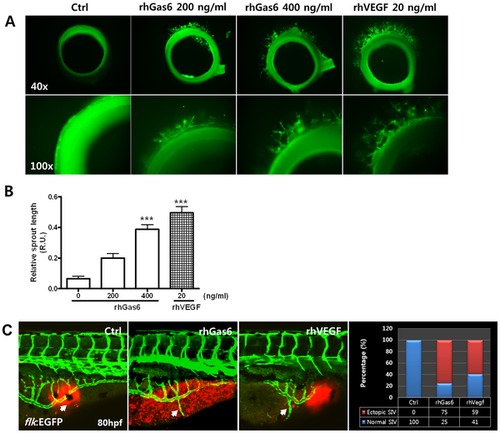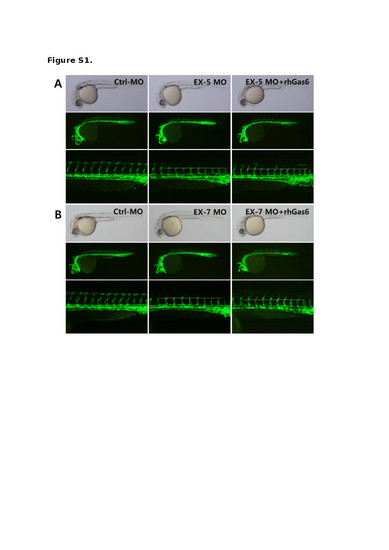- Title
-
Gas6 stimulates angiogenesis of human retinal endothelial cells and of zebrafish embryos via ERK1/2 signaling
- Authors
- Kim, Y.S., Jung, S.H., Jung, D.H., Choi, S.J., Lee, Y.R., and Kim, J.S.
- Source
- Full text @ PLoS One
|
Angiogenic responses are induced by rhGas6 in rat aortic rings and in zebrafish embryos. (A) Representative images after 5 day incubation with rhGas6 and rhVEGF. Sprouts from rat aortic rings are shown in the Matrigel control, rhGas6, and rhVEGF after treatment for 5 days, as described in the Materials and Methods. (B) Quantification of sprout length from aortic rings revealed increased sprout formation after a 5-day treatment with rhGas6 and rhVEGF in Matrigel. Data are expressed as mean ± SEM. (n = 4). ***p<0.001 vs. control. (C) Transgenic embryos (flk:GFP) at 50 hpf were injected into the perivitelline space with Texas Red dye (Ctrl), Texas Red dye and rhGas6 (300 ng/µl), or Texas Red dye and rhVEGF (5 ng/μl). After 30 h, embryos were photographed under a confocal microscope. In the controls, the formation of ectopic sprouts (arrow) is never observed, and the injected embryos of the rhGas6- and rhVEGF-treated embryos show ectopic sprouting of subintestinal vessels (SIVs). The experiment was repeated three times (Control, n = 28; rhGas6, n = 24; rhVEGF, n = 24). |
|
Knockdown of gas6 induces the inhibition of angiogenesis in intersegmental vessels. (A) The red arrows (Ex5:In5 and Ex7:In7) indicate morpholino target sites for splicing blocks. Primers (blue arrows, exon 1, forward primer; exon 8, reverse primer) were designed for the testing of morpholino efficacy, as described in the Materials and Methods. (B, C) Testing and quantification of morpholino nucleotide efficacy by RT-PCR in standard control MO (Ctrl-MO) and gas6 MO (EX5-MO and EX7-MO) treated embryos at 26 hpf. In control morphants, gas6 mRNA (768 bp, black arrow) is detectable by RT-PCR (B, first line). In gas6 EX5 morphants, the wild-type gas6 mRNA is undetectable by RT-PCR at doses of 2 and 5 ng/embryo. The morphant mRNA encodes a truncated form of the Gas6 protein. (C) In gas6 EX7 morphants, RT-PCR products reveal Ctrl-MO embryos expressing wild-type gas6 transcript, while EX7-MO embryos express two transcript variants at doses of 1 or 2 ng/embryo. The black arrow shows reduced expression of wild-type gas6 mRNA. The red arrow indicates results from aberrant splicing, resulting in a gain of ~250 base pairs of intron 7, which encodes a premature stop codon that occurs in the Gas6. (D) Angiogenesis defects in gas6 morphants. The flk:GFP transgenic zebrafish embryos were microinjected with Ctrl-MO (n = 30, 4 ng/embryo) and gas6 MO (EX5-MO, n = 35, 4 ng/embryo; EX7-MO, n = 34, 2 ng/embryo), and their blood vessel formation was examined at a cellular level in living embryos at 30 hpf. Normal formation of intersegmental vessels, as shown by GFP-positive endothelial cells, is observed in Ctrl-MO embryos, but severe vascular defects is observed in gas6 MO-injected embryos. The experiment was repeated two times. |
|
Activation of ERK is regulated by Gas6. (A) rhGas6 induced signaling pathway in HRMECs. Cells were incubated with rhGas6 (400 ng/ml) at various times, and cell lysates were subjected to western blotting with specific antibodies, as described in Materials and Methods. (B) Immunofluorescence staining for pERK1/2 and Hoechst staining was performed, as described in Materials and Methods. Representative images of p-ERK1/2 staining in rhGas6-treated HRMECs. (C, D) PD98059, SB203580, or U0126 was preincubated for 30 min, and HRMEC responses to rhGas6 or rhVEGF were determined by western blotting using specific antibodies. The experiment was repeated three times. (E) Phospho-ERK1/2 staining in the trunk of 26 hpf embryos [Ctrl-MO embryo (n = 7); gas6-MO injected embryo (n = 8); U0126-treated embryo (n = 8)] and quantitative analysis of zebrafish p-ERK1/2 expression by whole-mount immunostaining. The gas6-morphant and U0126 treated embryos showed reduction of p-ERK1/2 protein expression compared to controls in the zebrafish trunk. The experiment was repeated two times. **p<0.01 vs. Ctrl-MO. |
|
Disruption of Gas6 signaling via the ERK pathway resulted in defective angiogenesis in HRMECs and in zebrafish. (A) U0126 was preincubated for 30 min, and HRMEC responses to rhGas6 or rhVEGF were determined using a scratch-wound healing assay. Lines indicate the same width of the gap, and migrating cells are marked with a red asterisk. Representative images at 6 h after generating the scratch are shown. The experiment was repeated three times. ***p<0.001, **p<0.01 vs. control, ###p<0.001, #p<.05 vs. U0126-treated cells. (B) At 30 h, fluorescent images show gross morphology of Ctrl-MO injected control (n = 34), gas6-morpholino [EX5-MO (n = 35), EX7-MO (n = 30)] injected, and SB203580 (n = 12), or PD98059 (n = 12), or U0126 (n = 12) treated embryos. The experiment was repeated two times. Fluorescent micrographs of live flk:GFP zebrafish Ctrl-MO embryos at 30 hpf. Note the proper formation of the major axial vasculature, dorsal aorta, and posterior cardinal vein, as well as the intersegmental vessel. Representative embryos treated with gas6-MO oligonucleotide, SB203580, PD98059, or U0126. Note the abnormal and stunted formation of the intersegmental vessel (longitudinal white bar in B). Representative mild defect of intersegmental vessels in the embryos treated with SB203580. ***p<0.001, *p<0.05 vs. Ctrl-MO. |
|
Contains the files: Figure S1. Recombinant human Gas6 rescues the phenotypic changes in gas6 morphant-injected embryos. (A) Embryos injected with gas6-exon5 morpholino. (B) Embryos injected with gas6-exon7 morpholino. Shown above are 30 hpf zebrafish Ctrl-MO-injected embryos (Ctrl-MO), embryos injected with a gas6 morpholino (EX-5 MO, EX-7 MO), injected with a gas6 morpholino and rhGas6 protein [EX-5 MO + rhGas6 (130 ng/µl), EX-7 MO + rhGas6 (130 ng/μl)]. Injection of rhGas6 resulted in a rescue of ISVs defects. ISVs formation is indicated by the white dotted line. |





